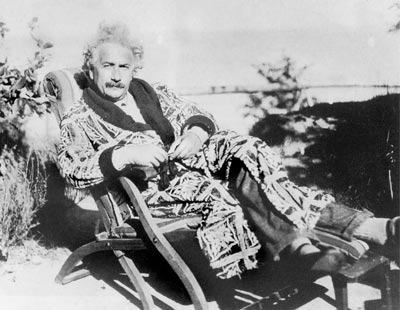
This Article From Issue
September-October 2007
Volume 95, Number 5
Page 443
DOI: 10.1511/2007.67.443
Einstein: His Life and Universe. Walter Isaacson. xxii + 675 pp. Simon and Schuster, 2007. $32.
Walter Isaacson's enjoyable and informative new biography of Albert Einstein provides a popular and judicious account of the latest Einstein scholarship. Isaacson, a former managing editor for Time, was, it seems, chiefly responsible for that magazine naming Einstein "Person of the Century" in 2000. It is thus fitting that Isaacson should kick off the 21st century with a comprehensive biography of him.
Isaacson is the first Einstein biographer to have had access to the trove of personal letters released under the terms of a bequest by Einstein's stepdaughter Margot Einstein, who at the time of her death in 1986 donated family correspondence to the collection of Einstein's papers already archived at Hebrew University, stipulating that the letters should not be published until 20 years after her death. This correspondence can now be found in volume 10 of the Collected Papers of Albert Einstein (Princeton University Press), but for those who wish to read only the highlights and to see the letters set in the context of Einstein's life, Isaacson's book provides an excellent summary.

From Einstein.
I should disclose that as one of the editors of the Einstein Papers Project, I had access to the sealed material in the Margot Einstein bequest before its publication. However, I did not work on editing the personal letters, but rather the scientific correspondence that formed part of volume 10. And although Isaacson has made exemplary use of the expertise offered by the project's editors, I was not involved in any way in aiding him in his work.
On hearing the phrase sealed material, the reader will naturally want to know what was so revealing about these family letters that made it essential they not see the light of day for so long a time. Anyone who reads Isaacson's book will find, as I did myself on first reading through the letters, that there is nothing here that is titillating to the modern reader. However, there is much that is of great human interest to anyone who knows something of Einstein's character.
The letters that form the core of the sealed material concern the period of Einstein's separation and divorce from his first wife, Mileva (née Maric). They contain nothing that would appear salacious to modern eyes, accustomed as people now are to divorce as a widespread phenomenon bringing little in the way of social stigma. But this familiarity with the problems of divorcemakes the impact of many of the letters all the greater for today's readers. Einstein's correspondence with his two young sons after the separation of the family in 1914 is particularly poignant. Those of us tasked with editing the scientific correspondence for volume 10, especially those of us with young families, were relieved not to have to work on the personal letters, some of which are frankly heartbreaking.
Einstein married Mileva Maric in 1903, over the objections of his parents. From letters that were originally in the possession of Einstein and Maric's descendants and were published by an earlier generation of editors at the Einstein Papers Project, it is now well known that Einstein and Maric had a daughter out of wedlock before their marriage. Little is known about this first child, except that she was not publicly acknowledged by her parents and may have died in early childhood. After marriage they had two sons, Hans Albert and Eduard (known as Tete), and lived together throughout Einstein's career as a patent clerk in Bern, Switzerland.
As Einstein's reputation as a physicist grew, he landed a series of academic positions, rising higher on the academic ladder until he was called to Berlin in 1914 to take up a very prestigious position at the Prussian Academy of Sciences. By this stage, his marriage was on the rocks. Maric briefly followed Einstein to Berlin, but it was quickly apparent to her that among his reasons for accepting the post was the opportunity to live near his cousin, Elsa Löwenthal (née Einstein), a widow with whom he had previously formed a romantic attachment. An angry Maric returned to Zurich with the children when she and Einstein agreed to separate.
The letters in the sealed material were in the possession of Elsa's family (Margot was the daughter of Elsa by her first husband and had a sister, Ilse, who served as Einstein's secretary for some years). Not only does the sealed material add a great deal of interest to Isaacson's book, but quotes from the rest of Einstein's correspondence are used effectively throughout the text. This is definitely one of the highlights of the biography.
A state of marital limbo suited Einstein and Maric well enough (although it seems likely that Maric hoped for an eventual reconciliation), but it was anathema to the very bourgeois Elsa not to have her relationship with Einstein regularized. Eventually, in 1916, Einstein asked Maric for a divorce, which she refused. When he persisted, she suffered a nervous breakdown, and Einstein realized he was in danger of becoming estranged from his children. He was, in any case, having difficulty even seeing them, because the war and the increasingly precarious nature of his own health made travel difficult (he suffered, at this time, from a life-threatening ulcer).

From Einstein.
Finally, in 1918, Einstein came up with a proposal that overcame Maric's objections. Because of the postwar collapse of the German mark, he had great difficulty supporting Maric and the boys, in spite of the determination of the new German government to hold on to their most prestigious (and now world-famous) scientist by means of liberal and frequent salary raises. Einstein now realized that the Nobel Prize, when he finally received it, would provide the hard currency (Swedish kronor) that could make Maric financially secure. Thus they reached a divorce agreement that specifically provided that the Nobel money would go to Maric. The divorce decree, since Einstein was the guilty party, restricted him from remarrying for two years, a stipulation he easily ignored since he lived in a different jurisdiction—the divorce was finalized under Swiss law in Zurich in February 1919, and he married Elsa a few months later in Berlin.
He did win the Nobel Prize within a few years, and the resourceful Maric managed very well off the money for the rest of her life. The eldest boy, Hans Albert, went on to become a successful engineer and a professor at Berkeley (most of Einstein's descendants live in California). The younger son, Tete, had a sad life, most of which was spent in institutions because of his fragile physical and mental health.
Isaacson's book does not focus exclusively on the period of Einstein's separation and divorce, or on his personal life. Indeed, Isaacson's coverage of Einstein's scientific work is thorough and accessibly written. Those with the stomach for it, and more important, the scientific background, will still prefer Abraham Pais's masterly work Subtle Is the Lord for Einstein's scientific life. But among the more popular biographies, readers will find that this one stands out in terms of space devoted to readable explanations of Einstein's theories. Relativity receives plenty of attention, of course, but nice, concise and informative accounts are also given of other significant discoveries, such as his invention, with the Indian physicist Satyendra Bose, of quantum statistics.
It is difficult to cover all of the many facets of Einstein's life in a book of any size, but Isaacson also manages to give a good account of his political involvement in various radical, pacifist and Zionist causes, although again some recent books, especially those by Fred Jerome, go into this important aspect of Einstein's life in much more detail. (Readers interested in this topic will also want to consult Einstein on Politics, a new collection of the physicist's reflections on the subject edited by David E. Rowe and Robert Schulmann.) But great as Einstein's allure remains, the majority of people will probably wish to read just one Einstein book, and this is one they should strongly consider. In addition to being comprehensive, accessible and well written, it is clearly the most up to date, making sensible use of the latest and most authoritative scholarship.

American Scientist Comments and Discussion
To discuss our articles or comment on them, please share them and tag American Scientist on social media platforms. Here are links to our profiles on Twitter, Facebook, and LinkedIn.
If we re-share your post, we will moderate comments/discussion following our comments policy.